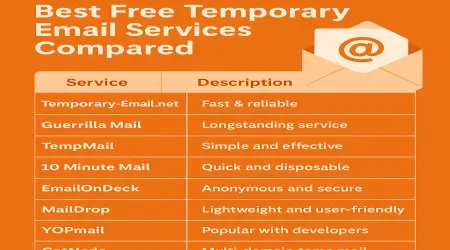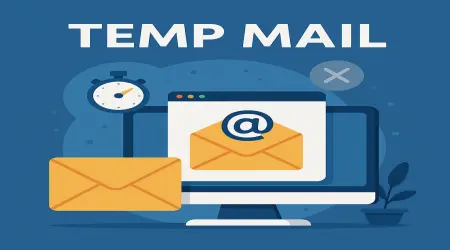

Why Every Web Developer Should Use Temporary Email in 2025
Introduction
Web development in 2025 is faster, more complex, and more privacy‑focused than ever. From creating test accounts to verifying sign‑ups across multiple environments, developers handle countless emails daily. Using personal or corporate emails for these tasks is inefficient, exposes sensitive data, and clutters inboxes.
Enter temporary email services — also called disposable or throwaway emails. These tools generate short‑lived, anonymous addresses perfect for development workflows. In this guide, we explore why every web developer should integrate temporary emails into their toolkit, how they work, their benefits, and the best services to use in 2025.
What Is Temporary Email?
A temporary email (or disposable email) is an email address created for short‑term use. Unlike permanent emails (e.g., Gmail, Outlook):
It requires no registration or personal data.
It expires automatically (minutes to hours).
It’s typically receive‑only, perfect for verification and testing.
It deletes messages and addresses after use, leaving no trace.
Why Temporary Email Matters for Web Developers
1. Testing User Registration Flows
Developers frequently test sign‑up forms, password resets, and email verification flows. Temporary emails allow fast, repeatable testing without creating dozens of permanent accounts.
2. Protecting Privacy
Using personal or corporate emails during testing risks exposing sensitive data. Disposable emails ensure anonymity and data isolation between testing and real environments.
3. Avoiding Inbox Clutter
Developers sign up for third‑party APIs, tools, and services daily. Using a temporary email keeps marketing spam out of personal or work inboxes.
4. Simulating Real‑World Scenarios
Fake users with disposable emails help test load handling, notification systems, and multi‑account interactions.
5. Speeding Up QA and Deployment
No need to log out, create new Gmail accounts, or clear cookies repeatedly. Temporary emails streamline rapid iteration and debugging.
How Temporary Email Works
Generate Address: Visit a service (e.g., Temporary‑Email.net) — an email address is instantly provided.
Use Address: Enter it into forms, test APIs, or simulate user sign‑ups.
Receive Mail: Access verification emails directly on the service page.
Auto‑Expire: After a set time (10 minutes to 24 hours), emails and addresses are deleted.
Benefits of Temporary Email for Web Developers
Enhanced Productivity
No time wasted managing multiple permanent accounts.
Rapid creation of test data for staging environments.
Better Security
Isolates test data from production emails.
Reduces exposure to phishing or malicious emails.
Realistic Testing
Simulates diverse user scenarios with unique addresses.
Tests bulk mailing, notifications, and email queues.
Cost‑Effective
Free to use; avoids purchasing additional domains or accounts.
Challenges and Limitations
Short Lifespan: Unsuitable for long‑term testing scenarios.
Public Inboxes: Some services are not private (anyone knowing the address can view emails).
Blocked by Some Sites: Major platforms may reject disposable domains.
Receive‑Only Limitation: Cannot send emails, only receive them.
Common Use Cases in Web Development
QA Testing
Validate registration flows across dev, staging, and production environments.
Confirm email notifications (welcome messages, password resets).
API Integration
Test email‑based authentication or notifications via third‑party APIs.
Load Testing
Simulate hundreds of sign‑ups with disposable addresses.
Multi‑Account Features
Verify user role functionality (admin, customer, guest) without multiple permanent emails.
Bug Reproduction
Isolate issues linked to user emails during debugging sessions.
Best Temporary Email Services for Developers in 2025
1. Temporary‑Email.net
Private inboxes, modern interface
Real‑time updates and fast expiration
Ideal for privacy‑focused developers
2. TempMail
Widely recognized and easy to use
Multiple domain options and auto‑refresh inbox
Public inbox (less private but convenient)
3. 10MinuteMail
Classic 10‑minute lifespan (extendable)
Lightweight and fast for quick verifications
4. Guerrilla Mail
Custom usernames and spam filtering
Good for semi‑longer test cases
5. Teamail
Next‑generation disposable email with encryption
Flexible lifespan (hours or days)
Designed for advanced privacy scenarios
Comparison Table: Best Temporary Emails for Developers
| Service | Privacy Level | Expiration Time | Features | Ideal Use Case |
|---|---|---|---|---|
| Temporary‑Email.net | High | 10–60 minutes | Private inbox | QA & staging tests |
| TempMail | Medium | 10–60 minutes | Auto-refresh | Quick sign‑ups |
| 10MinuteMail | Medium | 10 minutes | Lightweight | Instant tests |
| Guerrilla Mail | Medium | 1 hour+ | Custom alias | API load testing |
| Teamail | High | Flexible | Encrypted inbox | Privacy-focused devs |
Integrating Temporary Email into Developer Workflows
Automating with APIs
Some disposable email services provide APIs for generating addresses and retrieving emails programmatically. This allows automated end‑to‑end testing in CI/CD pipelines.
Browser Extensions
Developers can use extensions (e.g., TempMail Chrome Extension) to generate emails directly within their browser.
Combining with Test Data Generators
Pair temporary emails with fake name/address generators for realistic test user profiles.
Myths About Temporary Emails — Busted
Myth 1: They’re Only for Spammers
Reality: Millions of legitimate developers and testers use temporary emails to protect privacy and streamline workflows.
Myth 2: They’re Insecure
Reality: Many services offer private inboxes and HTTPS encryption; use trusted providers for safety.
Myth 3: They Replace Permanent Emails
Reality: They complement permanent accounts for specific scenarios (testing, spam control).
Myth 4: They’re Unnecessary for Professionals
Reality: Even enterprise developers use disposable emails to separate testing from production.
Best Practices for Developers Using Temporary Emails
Use private services (e.g., Temporary‑Email.net) for confidential tests.
Combine with VPNs to hide IP addresses and enhance anonymity.
Avoid using disposable emails for sensitive accounts (e.g., banking).
Clear cookies and cache after testing to avoid cross‑tracking.
Automate disposable email generation via API for efficient workflows.
Why 2025 Is the Year for Temporary Emails
Privacy‑first mindset: Increased data regulations (GDPR, CCPA) push developers to isolate test data.
Faster development cycles: Agile and DevOps require quick, disposable test environments.
Growing cyber threats: Using temp emails reduces attack surface during testing.
Global remote teams: Cloud‑based tools like disposable emails enable seamless collaboration.
Future Trends
AI‑powered spam detection within disposable email services.
Custom domain disposable emails for branded developer environments.
Blockchain‑secured temp emails ensuring tamper‑proof test data.
Deep integration with developer tools (GitHub, GitLab, Docker).
Frequently Asked Questions (FAQ)
Q: Are temporary emails safe for development?
Yes. They’re safe for testing, provided you avoid sensitive production data.
Q: Can I automate disposable emails in tests?
Yes. Many services offer APIs for automated generation and retrieval.
Q: Do temporary emails work for staging environments?
Absolutely. They’re perfect for staging and QA workflows.
Q: Can I use them for long-term projects?
No. They expire quickly; use them only for short‑term testing.
Q: Are they blocked by major services?
Some platforms block disposable domains; test with multiple providers.
Conclusion
Temporary email is no longer a niche tool — it’s a must‑have for modern web developers in 2025. From protecting privacy to accelerating testing, disposable emails streamline workflows and keep development environments clean and secure.
By choosing trusted providers like Temporary‑Email.net, integrating APIs, and following best practices, developers can enhance productivity, reduce spam, and safeguard personal data — all while focusing on building better web experiences.
Target Keywords
temporary email for web developers, disposable email 2025, QA testing tools, email privacy for developers, best temp mail for devs

